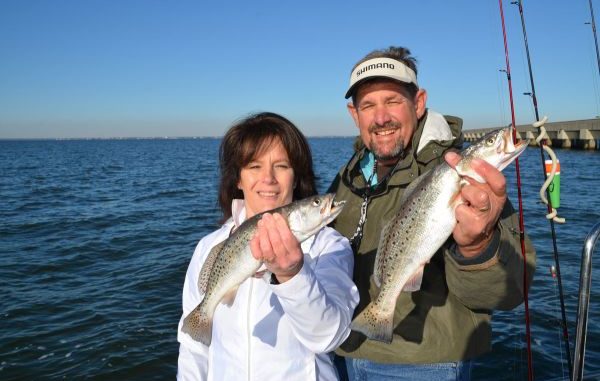
Tom Cresson’s fishing style has changed since he and his wife purchased their lake house and Karen started fishing.
“I used to fish exclusively artificials. Now we fish mostly with live bait,” Tom Cresson said. “We take a lot of customers and families fishing. A lot of them only fish a few times a year or are kids.
“A live shrimp on the line increases the chance of catching by 99 percent.”
Their bread-and-butter rigs are sliding corks or a drop-shots. Both are essentially used to fish very near the bottom.
Their sliding cork rig is built around an unweighted popping cork threaded on the line above a ¾-ounce egg sinker. One plastic bead is threaded above the cork (to work against a stopper), and one bead is threaded below the weight (to protect the knot attaching the line to the swivel).
Tom likes to use an unconventional material for the line stoppers — dental rubber bands. He cuts the small band to open it up, pulls his fishing line taut, and then ties on the rubber band.
“It’s a pain to put on the line, but it is very durable,” Tom said. “When I fish with a kid with braces, I make friends with him.”
The position of the rubber band should be checked often, Tom counseled. “A heavy fish can cause the rubber stopper to catch on the rod tip and move.”
The stopper is tied on the line 11 feet above the swivel. It is easy to tell if it is set too deep because the cork will float sideways rather than vertically.
Attached to the swivel is a 20-inch leader made of 30-pound-test monofilament. Tom prefers a 1/0 kahle hook for use with live bait.
Karen’s favorite setup is a drop-shot rig, also made of 30-pound-test monofilament. A No. 6 4X treble hook is tied one on end of a 30-inch piece of the material, and a 1-ounce bank sinker is tied to the other.
A loop is tied in the leader with an overhand knot so the hook leg is twice as long as the sinker leg.
“I like it because I can feel it,” said Karen. “You don’t have to concentrate on watching the cork.”
“I fish with a drop-shot, too,” Tom said, “but when I’m scouting for fish, I find a sliding cork lets me cover a lot more area. Lots of times when I find fish with a sliding cork, I shift to a drop-shot rig like Karen.”
Tom advised newcomers to the Tressels to cover a lot of water with their trolling motor until they find fish, and then stop to fish them. When the bite stops in a spot, it is important to move on.
“A lot of time, I fuss at myself for spending too much time on a spot after they quit biting,” he said. “You will get favorite spots. At first, the whole bridge looks alike, but the fire breaks are numbered and the bridge has mile markers.”
Fire breaks are small sections of the bridge that look different from the rest of the bridge. They hail from the day when the bridge was constructed of wood. Fire breaks were made of concrete, so if the bridge caught fire, only one section of it would burn rather than the entire bridge.
